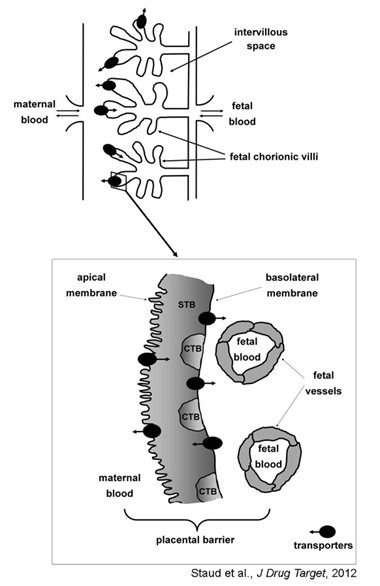 Placenta is a temporary organ that, among many other functions, regulates the exchange of nutrients, waste products and xenobiotics between mother and fetus. Placenta used to be described as a mechanical barrier that only passively protects the fetus against maternal toxins. However, in 1998, Lancas and colleagues reported P-glycoprotein-mediated efflux of avermectin in the placenta and stressed the role of ATP-binding cassette (ABC) transporters in fetal protection (Lankas et al., 1998). Subsequent disclosure of several other drug transporters in the placental barrier has brought new insights into the question of materno-fetal transport of drugs, fetal protection and detoxication and it has become apparent that efflux and uptake transporters decisively control drug transport across the placenta. To date, the best described of placental drug transporters are P-glycoprotein (Ceckova-Novotna et al., 2006) and breast cancer resistance protein of the ABC drug efflux transporters family (Hahnova-Cygalova et al., 2011).
Placenta is a temporary organ that, among many other functions, regulates the exchange of nutrients, waste products and xenobiotics between mother and fetus. Placenta used to be described as a mechanical barrier that only passively protects the fetus against maternal toxins. However, in 1998, Lancas and colleagues reported P-glycoprotein-mediated efflux of avermectin in the placenta and stressed the role of ATP-binding cassette (ABC) transporters in fetal protection (Lankas et al., 1998). Subsequent disclosure of several other drug transporters in the placental barrier has brought new insights into the question of materno-fetal transport of drugs, fetal protection and detoxication and it has become apparent that efflux and uptake transporters decisively control drug transport across the placenta. To date, the best described of placental drug transporters are P-glycoprotein (Ceckova-Novotna et al., 2006) and breast cancer resistance protein of the ABC drug efflux transporters family (Hahnova-Cygalova et al., 2011).
However, in the recent years, many other transporters have been revealed in the placenta and the topic of transplacental pharmacokinetics is continuously evolving (Staud et al., 2012). It is thus obvious that transplacental passage of drugs can no longer be predicted simply on the basis of their physical-chemical properties and binding to plasma proteins; placental drug transporters, their functional expression in the trophoblast and the possibility of drug interactions must be considered to optimize therapy in pregnant women.
Literature:
Ceckova-Novotna M, Pavek P and Staud F (2006) P-glycoprotein in the placenta: Expression, localization, regulation and function. Reprod Toxicol 22:400-410.
Hahnova-Cygalova L, Ceckova M and Staud F (2011) Fetoprotective activity of breast cancer resistance protein (BCRP, ABCG2): expression and function throughout pregnancy. Drug Metab Rev 43:53-68.
Lankas GR, Wise LD, Cartwright ME, Pippert T and Umbenhauer DR (1998) Placental P-glycoprotein deficiency enhances susceptibility to chemically induced birth defects in mice. Reprod Toxicol 12:457-463.
Staud F, Cerveny L and Ceckova M (2012) Pharmacotherapy in pregnancy; effect of ABC and SLC transporters on drug transport across the placenta and fetal drug exposure. J Drug Target 20:736-763.